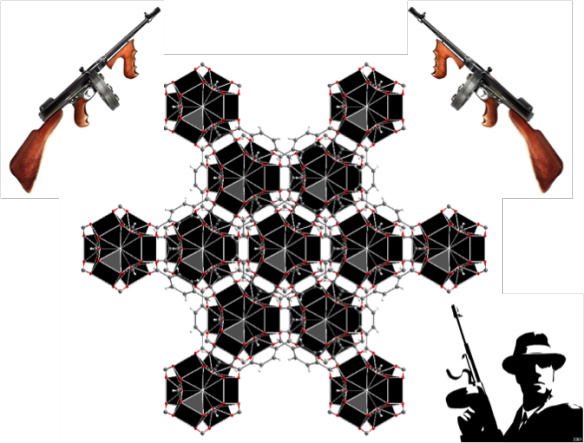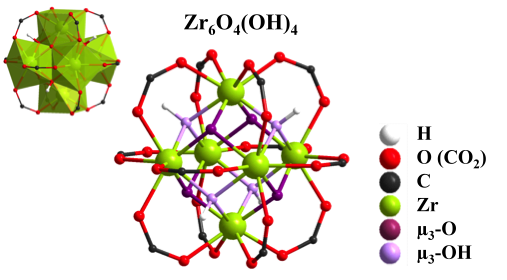The MOFIA and the boss of the crown family: the UiO-66
What does the boss UiO-66 look like?

This picture was drawn using Diamond structure visualisation software and 'extra' images from http://eslkidsgames.com/2012/08/esl-mafia-game-for-teens.html.
"MOFIA": what is that?
It is just a nickname for the scientific community working on Metal Organic Frameworks, acronymed MOFs, thus the community is the MOFIA.
The boss of the crown family, namely the UiO-66, is "probably" the most famous MOF of these past 6 years, now taking care of the family over the HKUST-11 and MOF-52. This solid has been reported by Cavka et al. in 20083 and has generated quite a lot of enthusiasm from the "Mofia". There is probably UiO-66 in each lab around the world working on MOFs.
This MOF was basically the first built up from a tetravalent metal, the zirconium Zr4+ and thus a novel inorganic cluster (see below), which has given rise to a robust solid, i.e. much more stable than most known MOFs. Indeed, it has been shown that, in general, by increasing the valence of the metal, the chemical and thermal stabilities of MOF increases.4 The linker is the terephthalate.

Now, the question is "how long will it remain the big boss?", the challenge being that you cannot just kill it, you need to find a material that is better! The "Mofia" war is opened!!!
Where did the structure come from?
The structure comes from a paper of Cavka et al. published in the Journal of the American Chemical Society in 2008.3
References
- Chui, S. S.-Y.; Lo, S. M.-F.; Charmant, J. P. H.; Orpen, A. G.; Williams, I. D., A Chemically Functionalizable Nanoporous Material [Cu3(Tma)2(H2O)3]N. Science 1999, 283, 1148-1150.
- Rosi, N. L.; Eckert, J.; Eddaoudi, M.; Vodak, D. T.; Kim, J.; O’Keeffe, M.; Yaghi, O. M., Hydrogen Storage in Microporous Metal-Organic Frameworks. Science 2003, 300, 1127-1129.
- Cavka, J. H.; Jakobsen, S.; Olsbye, U.; Guillou, N.; Lamberti, C.; Bordiga, S.; Lillerud, K. P., A New Zirconium Inorganic Building Brick Forming Metal Organic Frameworks with Exceptional Stability. Journal of the American Chemical Society 2008, 130, 13850-13851.
- Devic, T.; Serre, C., High Valence 3p and Transition Metal Based Mofs. Chemical Society Reviews 2014, 43, 6097-6115.






